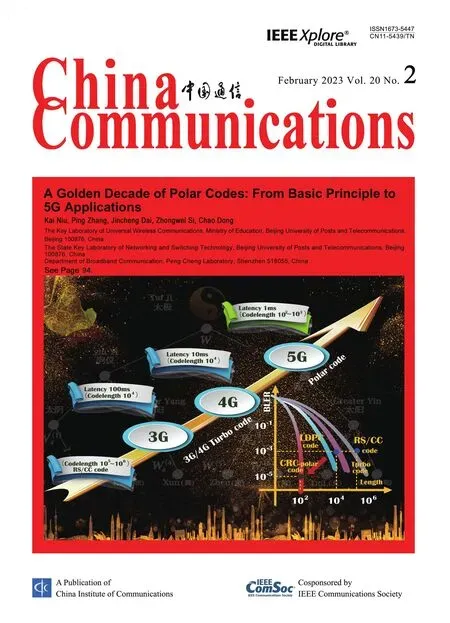Convergence of Digital Twin and 6G enabled Edge Intelligence: Theories,Algorithms and Applications
2023-04-05YuanWu,XuChen,FengLyu等
With the growing maturity of the advanced edge-cloud collaboration and integrated sensing-communication-computing systems,edge intelligence has been envisioned as one of the enabling technologies for ubiquitous and latency-sensitive machine learning based services in future wireless systems.However,with the ever-growing scale of the edge-cloud systems as well as the rapid advances in future 6G technologies,there exists a critical issue that limits the deep penetration of future 6G enabled edge intelligence services,i.e.,how to accurately evaluate the performance when leveraging the emerging yet pre-matured technologies,protocols,and algorithms into the existing systems.The recent advanced Digital Twin (DT) has been envisioned to provide a fault-tolerant and low-cost platform for accurately simulating and evaluating the emerging technologies,protocols,and algorithms,without causing any negative influence on the existing systems.The essence of DT aims at enabling a systematic and fully digitalized modeling systems that can produce accurate digital model of the corresponding physical identity in the DT-space.By simulating the digital models in the DT-space,DT can accurately and reliably predict and estimate the dynamics and evolutions of the physical networks during the entire life cycle,thus providing a timely and risk-free methodology for evaluating the performance when adopting the emerging yet pre-matured technologies,protocols,and algorithms for network management.Therefore,DT has been considered as an efficient scheme for addressing the challenging issue to 6G enabled edge intelligence,and thus has attracted lots of interests from both academia and industries.It is observed that DT and edge intelligence can benefit each other,which thus yields a deep convergence of themselves.On the one hand,the increasing network scale,complexity,and security risks of edge intelligence raise more challenges to the security and reliability.DT can accurately simulate and predict the performance of edge intelligence services and thus provide accurate benchmark references for edge services.On the other hand,to enable accurate mapping and real-time synchronization between the physical identifies and their digital models,DT necessitates massive sensing of the targeted physical identifies as well as the consequent data analytics and modeling.Moreover,efficient yet low-latency transmissions of the sensing data and the data analytics (e.g.,the inference models) are required.6G edge intelligence can naturally provide a solution to these requirements.Therefore,this special issue focuses on the convergence of DT and 6G enabled Edge Intelligence,from the perspectives of theories,algorithms,and applications.
The special issue has attracted almost thirty high-quality submissions,and each submission goes through a rigorous review process by three anonymous and independent reviewers.Six papers are finally accepted for publication in this issue.The key contributions of the accepted papers are summarized as follows.
Content delivery and video analytics are two most important applications for edge intelligence.In the paper titled “Quality-Aware Massive Content Delivery in Digital Twin-Enabled Edge Networks”,the authors leveraged the integration of DT and edge networks for achieving an efficient yet quality-aware massive content delivery.Specifically,a quality-of-decision driven compression mechanism for video analytics is proposed for machine-centric systems and a quality-of-experience driven video enhancement scheme is designed for user-centric communication systems.In the paper titled“Edge-Coordinated Energy-Efficient Video Analytics for Digital Twin in 6G”,the authors considered the real-time video analytics via the cameras mounted on mobile devices and proposed a DT enabled edge-coordination system that can take several important issues into considerations,e.g.,time-varying video frames captured from different mobile devices which are energy limited,and video analytics accuracy and latency.
DT cannot make a perfect estimation or predication of physical systems due to various practical limits,e.g.,measurement noise or delay.Thus,in the paper titled “The Unpredictability of Digital Twin for Connected Vehicles”,the authors accounted for those practical limits and adopted connected vehicles as a case study to investigate the sources of unpredictability of digital twin and the corresponding guidelines for exploiting DT for edge systems.Security and reliability are crucial to the success of convergence of DT and edge intelligence.In the paper titled “Endogenous Security-Aware Resource Management for Digital Twin and 6G Edge Intelligence Integrated Smart Park”,the authors considered the poisoning attacks on DT model training and proposed an endogenous security-aware resource allocation scheme for state information evaluation and attack detection in edge systems.Recently,federated learning has been envisioned as a promising distributed edge framework.In the paper titled “Digital Twin-Assisted Knowledge Distillation Framework for Heterogeneous Federated Learning”,the authors exploited DT for efficiently training the large-size teacher model at the edge server and proposed a knowledge distillation framework for heterogeneous federated learning in which users can select their respective neural network models on demand and distill knowledge from the large teacher model.Finally,in the paper titled“Design and Implementation of Secure and Reliable Information Interaction Architecture for Digital Twins”,the authors designed a secure information interaction framework for DT by leveraging AES and digital pointer and demonstrated the secure interaction between the physical entity and the virtual entity by building a platform with universal software radio peripheral and GNU radio.
The guest editors would like to express great thanks to all authors and reviewers for their contributions to this special issue.Last but not the least,all guest editors also would like to express deep thanks to the Editor-in-Chief ofChina Communicationsas well the editorial team ofChina Communicationsfor their strong support,very professional guideline,and timely assistance.
杂志排行
China Communications的其它文章
- Design and Implementation of Secure and Reliable Information Interaction Architecture for Digital Twins
- The Development Trends and Research Fronts in Orbital Angular Momentum Technology: A Bibliometric Analysis
- A Dynamic Bayesian-Based Comprehensive Trust Evaluation Model for Dispersed Computing Environment
- Research on Network Cognition Model and Mechanism of Intelligent Information Network
- Low-Density Parity-Check Codes: Highway to Channel Capacity
- Iterative Phase Noise Suppression for Full-Duplex Communication Systems
